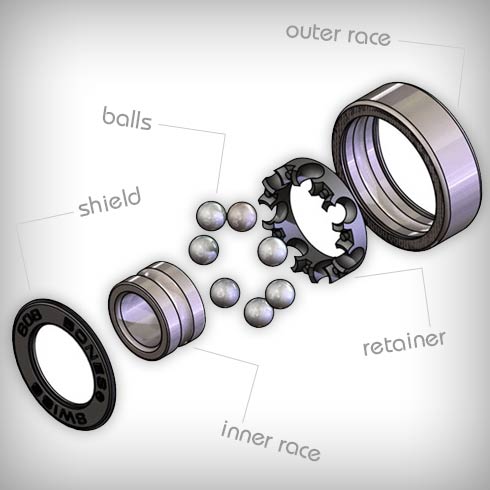For those unaware of what a bearing does, it makes the wheel go round. Tiny steel balls (or ceramic) set on a circular track (race) inside the ring work in combination with the fixed axel of the truck and inner hub of the wheel to allow the wheelspin when force is exerted.All longboard (skateboard) bearings come in a standard size to fit within longboard and skateboard wheels.
Many factors separate what makes a good longboard bearing different than a not so good bearing. These include but are not limited to speed, durability, load capacity (vertical-axial-torsional), materials, surface finish, lubrication and most commonly tolerance (ABEC rating). Unfortuntly, most bearing companies do not release details on much of what makes their bearing different from the pack other than ABEC rating and in some cases the materials. However, this guide will expose you to the details of what actually do make a difference making you smarter and able to better understand why some bearings are $10 and some are $130.
bearing ABEC rating
ABEC ratings are the most common spec you’ll see tied an individual model of bearing but also the most misunderstood spec. This rating is a measure of tolerance or the space that is allowed to be between the steel balls and the inner and outer race (track the steel balls move across). Many people associate a higher ABEC rating to mean a faster bearing which is not allways the case. While a tighter tolerance (balls are closer to inner and outer race or higher ABEC rating) will result in a more effecient bearing at higher speeds, other aspects like materials, shape of the race, lubrication and how the bearing performs under force from all angles also play into on how smooth, speedy and durable a bearing proves to be. In many cases, bearings with higher ABEC ratings use more precicion processes to ensure that all the other parts involved perform up to suit but just know that it is not ABEC rating alone that defines speed.
bearing loads
You don’t want to come back in another life as a longboard bearing. All the up and down, left to right, twists and turns would drive you crazy. If you were a good performing bearing, your track (the space between the inner and outer race) would be shaped in a way to provide the least amount of friction during all three major types of directional force. Vertical (up and down), axial (left and right) and torsional (twists and turns). A quality bearing will have a deeper groove to hold the steel balls in place so there is limited movement to cause more friction and slow you down. Minimizing friction is where the material and lubrication of the bearing plays a strong role for maximum speed.
bearing material
The material of the bearing is one of the most dominant factors on what makes a $10 bearing and what makes a $100 bearing. A precision tuned ceramic bearing will accelerate faster, roll further and last much longer than a traditional stainless steel bearing. This is why ceramic bearings cost a bit more. Paying $100+ for a set of bearings is not an option for everyone so know that there are may good stainless steel options as well. A better performing stainless steel bearing will contain higher quiality steel, better quailty balls and have a finer tuned surface to reduce friction.
bearing spacers
Many bearings will include litle metal cylintrical thingies called spacers. What do these do and do I really need them? Well, no you don’t absolutly need them to roll, but you should use them if you want to prolong the life of your bearings and optmizize your setup. A spacer will fit in between the bearings and keep the inner race spaced consistantly in relation to the wheel. The result is that you can tighten down the axle nuts properly and the wheels will still spin giving you a smoother, quieter and longer lasting ride.
bearing lubrication
If you’ve been absorbing what the past few pages have said about bearings, you’ll know it’s all about maintaining minimal friction. So it probably makes sense by this point that quality racing lubricants designed to work with the material of the bearing will result in a more smooth and better performing ride. Remember that higher quailty bearings are built to last longer but they also require special attention to keep them clean and performing tip top. Regular maintainence and cleaning of your bearings is allways reccomended to get the most life out of them.
bearing maintenance and cleaning
Clean bearings = happy bearings. Happy bearings = smooth and speedy rides. Smooth and speedy rides = more stoked!
Keep your bearings dirt free, moisture free and lubricated. Water will rust your bearings and dirt will erode the smoothness resulting in more friction and time to get new bearings. Follow these tips to clean your bearings and keep yourself more stoked…
- Remove the rubber shield with a small pin or paperclip by prying from the inner race.
- Wash the shield down with warm soapy water and wipe dry.
- With the shield removed, soak the bearings in your cleaning solution. Do not use a water based solution or WD-40. This will actually leave a film that attracts more dirt. A soak in Mineral spirits or kerosene followed by a dip and shake in isopropyl alcohol works well.
- Put the shield back on making sure it is set in place between the inner and outer ring grooves properly.
- Add a couple of drops of bearing oil or speed creme and go get stoked.
- NOTE: Some bearings do not have removable shields for easy access when deep cleaning. If your bearings do not have a removable shield, using some bearing oil or speed creme around the shield and spinning a few times can loosen some excess dirt/debris to help prolong the life of your bearings.
